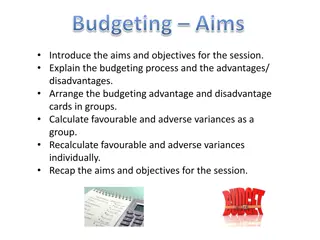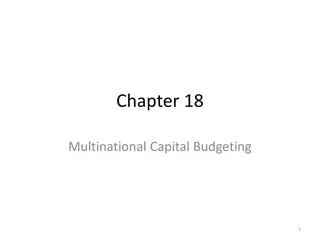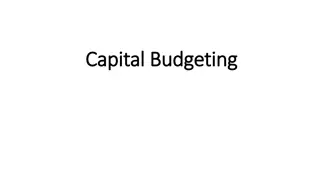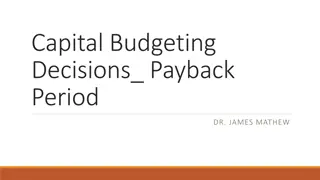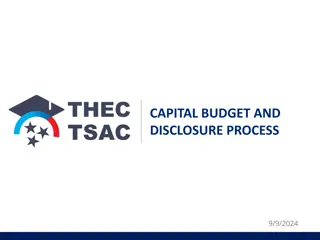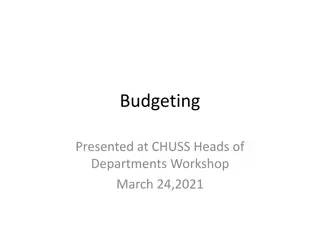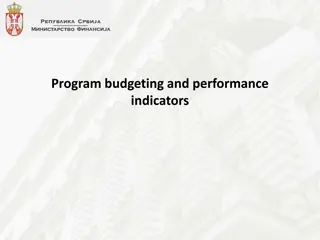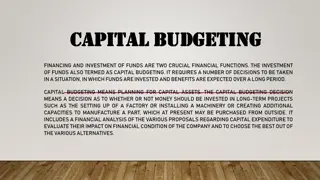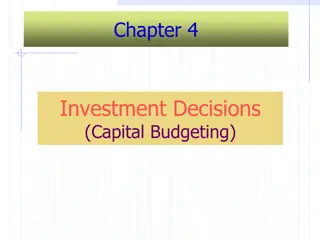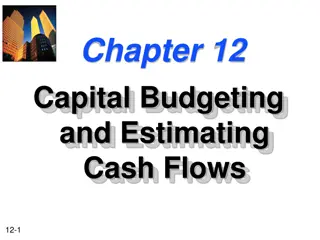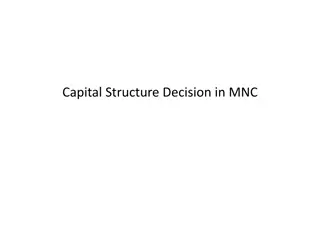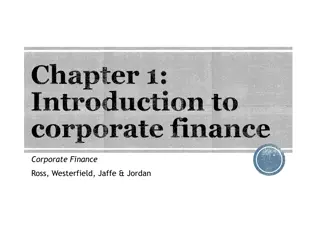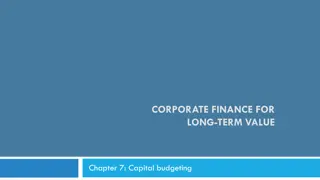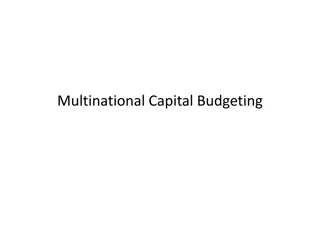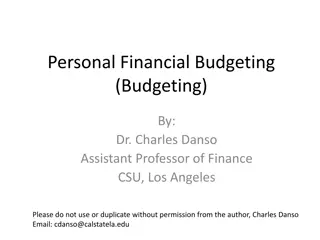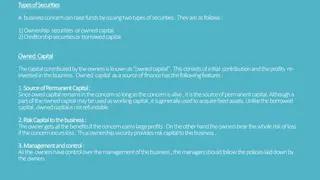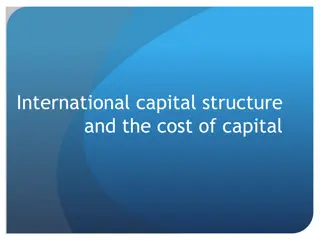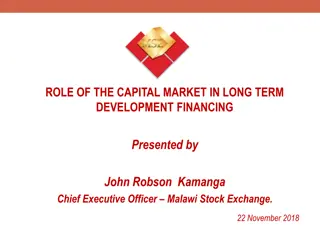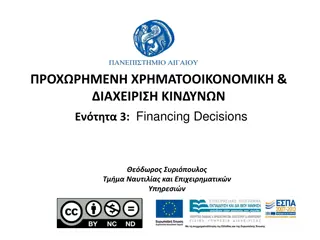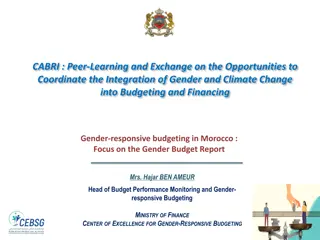Essential Capital Budgeting Decision Rules
Recommended capital budgeting decision rules include NPV analysis for assessing project feasibility and IRR for evaluating project returns. NPV helps in choosing projects with positive value, while IRR calculates the project's internal rate of return. Understanding these rules aids in making informed investment decisions.
Download Presentation

Please find below an Image/Link to download the presentation.
The content on the website is provided AS IS for your information and personal use only. It may not be sold, licensed, or shared on other websites without obtaining consent from the author. Download presentation by click this link. If you encounter any issues during the download, it is possible that the publisher has removed the file from their server.
E N D
Presentation Transcript
NPV Analysis The recommended approach to any significant capital budgeting decision is NPV analysis. NPV = PV of the incremental benefits PV of the incremental costs. When evaluating independent projects, take a project if and only if it has a positive NPV. When evaluating interdependent projects, take the feasible combination with the highest total NPV. The NPV rule appropriately accounts for the opportunity cost of capital and so ensures the project is more valuable than comparable alternatives available in the financial market.
Internal Rate of Return Definition: The discount rate that sets the NPV of a project to zero is the project s IRR. Conceptually, IRR asks: What is the project s rate of return? Standard Rule: Accept a project if its IRR is greater than the appropriate market based discount rate, reject if it is less. Why does this make sense? For independent projects with normal cash flow patterns IRR and NPV give the same conclusions. IRR is completely internal to the project. To use the rule effectively we compare the IRR to a market rate.
IRR Normal Cash Flow Pattern Consider the following stream of cash flows: 0 1 2 3 $400 $400 $400 -$1,000 Calculate the NPV at different discount rates until you find the discount rate where the NPV of this set of cash flows equals zero. That s all you do to find IRR.
IRR NPV Profile Diagram Evaluate the NPV at various discount rates: 250 Rate NPV 0 10 20 200 150 $200 -$5.3 -$157.4 100 50 NPV 0 -50 0 10 20 -100 -150 -200 Discount Rate At r = 9.7%, NPV = 0
The Merit to the IRR Approach The IRR is an approximation for the return generated over the life of a project on the initial investment. As with NPV, the IRR is based on incremental cash flows, does not ignore any cash flows, and (by comparison to the appropriate discount rate, r) take proper account of the time value of money and risk. In short, it can be useful.
Pitfalls of the IRR Approach Multiple IRRs There can be as many solutions to the IRR definition as there are changes of sign in the time ordered cash flow series. Consider: 0 1 2 -$100 $230 -$132 This can (and does) have two IRRs.
Pitfalls of IRR cont Disc.Rate 0.00% 10.00% 15.00% 20.00% 40.00% NPV -$2.00 $0.00 IRR1 $0.19 $0.00 IRR2 -$3.06 0.5 0 0 10 15 20 40 -0.5 -1 NPV -1.5 -2 -2.5 -3 Discount Rate
Pitfalls of IRR cont 3 2.5 2 1.5 NPV 1 0.5 0 0 10 15 20 40 -0.5 Discount Rate
Pitfalls of IRR cont Mutually exclusive projects: IRR can lead to incorrect conclusions about the relative worth of projects. Ralph owns a warehouse he wants to fix up and use for one of two purposes: Store toxic waste. Store fresh produce. A. B. Let s look at the cash flows, IRRs and NPVs.
Mutually Exclusive Projects and IRR Project A B Year 0 -10,000 10,000 -10,000 1,000 Year 1 Year 2 1,000 1,000 Year 3 1,000 12,000 Project NPV @ 0% $2000 $4000 NPV @ 10% $669 $751 NPV@ 15% $109 -$484 IRR A B 16.04% 12.94%
5000 A B 4000 3000 NPV 2000 1000 0 0% 10% 15% -1000 Discount Rate At low discount rates, B is better. At high discount rates, A is better. But A always has the higher IRR. A common mistake to make is choose A regardless of the discount rate. Simply choosing the project with the larger IRR would be justified only if the project cash flows could be reinvested at the IRR instead of the actual market rate, r, for the life of the project.
Project Scale and the IRR Because the IRR puts things in terms of a rate it may not tell you what interests you; which investment will create the most wealth . Example: Project A B Investment -$1,000 -$10,000 Time 1 +$1,500 +$13,000 IRR 50% 30% NPV at 10% $363.64 $1,1818.18
Summary of IRR vs. NPV IRR analysis can be misleading if you don t fully understand its limitations. For individual projects with normal cash flows NPV and IRR provide the same conclusion. For projects with inflows followed by outlays, the decision rule for IRR must be reversed. For Multi-period projects with changes in sign of the cash flows, multiple IRRs exist. Must compute the NPVs to see what decision rule is appropriate. IRR can give conflicting signals relative to NPV when ranking projects. I recommend NPV analysis, using others as backup.
Payback Period Rule Frequently used as a check on NPV analysis or by small firms or for small decisions. Payback period is defined as the number of years before the cumulative cash inflows equal the initial outlay. Provides a rough idea of how long invested capital is at risk. Example: A project has the following cash flows Year 0 Year 1 Year 2 Year 3 Year 4 -$10,000 $5,000 $3,000 $2,000 $1,000 The payback period is 3 years. Is that good or bad?
Payback Period Rule An adjustment to the payback period rule that is sometimes made is to discount the cash flows and calculate the discounted payback period. This new rule continues to suffer from the problem of ignoring cash flows received after an arbitrary cutoff date. If this is true, why mess up the simplicity of the rule? Simplicity is its one virtue. At times the discounted payback period may be valuable information but it is not often that this information alone makes for good decision-making.
Economic Profit or EVA EVA and Economic Profit Economic Profit The difference between revenue and the opportunity cost of all resources consumed in producing that revenue, including the opportunity cost of capital Economic Value Added (EVA) The cash flows of a project minus a charge for the opportunity cost of capital
Economic Profit or EVA EVA When Invested Capital is Constant EVA in Period n (when capital lasts forever) = n n EVA C rI where I is the project s capital, Cn is the project s cash flow at time n, and r is the cost of capital. (r I ) is known as the capital charge
Economic Profit or EVA EVA When Invested Capital is Constant EVA Investment Rule Accept any investment for which the present value (at the project s cost of capital) of all future EVAs is positive. When invested capital is constant, the EVA rule and the NPV rule will coincide.
Example Problem Ralph has an investment opportunity which requires an upfront investment of $150 million. The annual end-of-year cash flows of $14 million dollars are expected to last forever. The firm s cost of capital is 8%. Compute the annual EVA and the present value of the project.
Example Solution EVA each year is: = EVA C rI n n = 8% $150 million = $14 million $2 million EVA n The present value of the EVA perpetuity is: $2 million $25 million 8% = = PV
Economic Profit or EVA EVA When Invested Capital Changes EVA in Period n (when capital depreciates) = (Depreciation in Period ) EVA C rI n 1 n n n Where Cnis a project s cash flow in time period n, In 1is the project s capital at time n 1, and r is the cost of capital When invested capital changes, the EVA rule and the NPV rule continue to coincide.
Example Ralph is considering an investment in a machine to manufacture rubber chickens. It will generate revenues of $20,000 each year for 4 years and cost $60,000. The machine is expected to depreciate evenly over the 4 years. The current interest rate is 5% Should he invest in the machine?
Example Using the NPV rule we have a cost of $60,000 and benefits that look like a 4 year annuity. The NPV is 20 $ 000 , 1 = 60 $ + = 000 , 1 10 $ 919 , 01 . NPV 4 . 0 05 . 1 ( 05 ) Indicating that this is a valuable endeavor.
Example For EVA we calculate Year Capital Cash Flow Capital Charge Depreciation EVAn 0 $60,000 1 $45,000 $20,000 ($3,000) ($15,000) ($15,000) ($15,000) ($15,000) $2,000 $2,750 2 $30,000 $20,000 ($2,250) 3 $15,000 $20,000 ($1,500) 4 $0 $20,000 ($750) $3,500 $4,250 The present value of EVA is then: , 2 $ 000 , 2 $ 750 , 3 $ 500 , 4 $ 250 = + + + = ( ) 10 $ 919 , 01 . PV EVA 2 3 4 . 1 05 . 1 05 . 1 05 . 1 05



